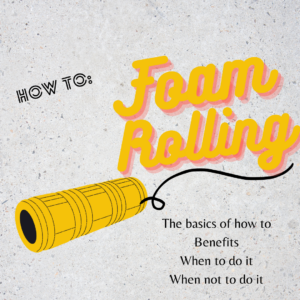
How to:
First, set your self up for success and buy a smooth foam roller. The bumpy ones can just cause unnecessary bruising and discomfort. Also, try and find a longer roller, the width- 2 feet or 3 feet will allow you to use the roller in a variety of ways.
You will be in a plank, side plank or reverse plank (facing up) to roll your legs and glutes and it can be challenging to hold up your body weight if you don’t regularly do so.
Foam rolling is basically exactly as it is stated, roll on the foam roller in any spot that feels good. It can be a bit uncomfortable at times but try not to go above a 6 on a pain scale out of 10- 10 being the worst pain you have felt.
Starting in a plank position, roll from the point of your hips down to just above your knees. Then turn into a side plank position and roll from the top of the pelvis through the side of the hip to above the knee. You may find it nice to pause at the dip in your hip between the pelvis and the leg bone. Then turn into a reverse plank position and sit on the roller, roll from just above your sit bones down to behind the knee. Also in this position you can roll the calves, start below the knee and roll down to the ankle.
Keep rolling back and forth on the roller as many times as you want in these positions, always moving at a pace comfortable for you. Doing one leg at a time will put more pressure on that group of muscles.
Benefits:
Foam Rolling can be a bit of a workout. You will be in a plank, side plank or reverse plank (facing up) to roll your legs and glutes and it can be challenging to hold up your body weight, for this reason foam rolling is great way to warm up prior to exercises.
Foam Rolling can also be a good way to cool down from exercise as you can move slower on the roller to lower your heart rate and at the same time provide compression and fascial manipulation to the tissues while the body is warm. The compression will push blood out of the tissues then allow a rush of new blood bringing with it nutrients and oxygen to your tired muscles and tissues.
Contraindications:
Avoid rolling over injured areas or if rolling will put you in a position that can affect an injury that you aren’t targeting with the roller. Talk to a professional before trying it out and to get a personalized training experience.
Indications:
Anyone who has sore, tired or achy muscles and those who feel fine but wish to bring fresh blood and nutrients into their tissues before or after a workout. You can also do Foam rolling at any time of the day, it does no have to coincide with a workout.
Recent Comments